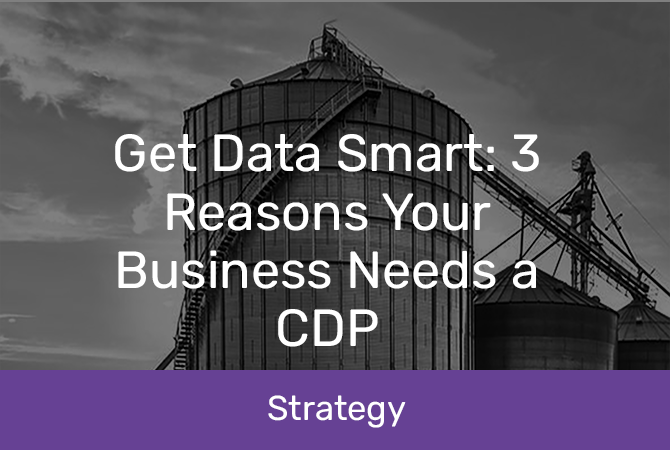
Get Data smart: 3 reasons your business needs a CDP
Disorganised data is overwhelming.
Imagine you’re sitting in front of a seemingly impossible maths problem – one you know is incredibly important to solve. In a box next to you is all you need to solve the problem, but it doesn’t seem to make much sense: you’ve been given 572 tiny snakes, a handful of mayonnaise, more sticks than you can count, a couple of ticking time-bombs, three angry rabbits and a bunch of overdue books. Oh, and there are a few million more boxes (each with equally confusing contents) hidden in various places around you – all of which are somehow supposed to help you solve the ugly problem staring back at you?
Even the most intelligent of us would find ourselves at a loss if put in this situation. Why? Because even though the format of the problem itself is in our realm of expertise (we’ve all done maths before), the tools provided to address the problem are in a form that we have no experience interpreting. The same issue, albeit slightly less outlandish, occurs constantly in the business world when companies try to make sense of their disparate data.
According to research from MIT, only 0.5 per cent of all data is ever analysed and used. Shocking as it might be, that statistic makes sense when you think about it – for the average business professional, deriving meaning from a colossal and disorganised set of data is painfully difficult and overwhelming. Organisations are faced with innumerable challenges (such as campaign management, forecasting future profits and justifying customer loyalty programmes) that always seem to tie back to their business and customer data. However, when this data is spread out in a jumbled mess across various platforms, it’s astonishingly hard for the business (even the IT team) to make sense of it and come away with any actionable insights.
To address this issue, companies need to consolidate the specific data needed to solve the problem at hand and keep it in an organised and accessible format, separated from the rest of the company data. Though there are numerous ways to manage and organise big company data, there’s one tool in particular that streamlines your data analysis, both for the current challenge and for future endeavours. You guessed it – a Customer Data Platform (CDP)(also known as a Datamart).
![]() What is a CDP versus a Data Warehouse (and do I really need either)?
What is a CDP versus a Data Warehouse (and do I really need either)?
Before we look at the definition of a CDP, it makes sense to first define a term you’ve probably come across if you’ve done any research into better data management: data warehouse. Designed to eliminate data silos, these enormous repositories are essentially a place to store all company data so that disparate pieces of information aren’t spread across a number of platforms. The mistake most people make, however, is thinking that a data warehouse is the solution to their problem – the warehouses are designed simply as all-encompassing storerooms and don’t actually help companies aggregate the data they need to analyse in order to solve a particular issue. Getting that level of specificity requires a more targeted approach, and this is where data warehouses are outsmarted by CDPs.
Imagine that a data warehouse is like your inbox: information is constantly flowing into it, some of which is useful for a particular project you’re working on, some of which is not. Sure, it’s great having all of your emails in one place, especially the ones relating to your project, but viewing one email at a time is not going to give you a comprehensive view of all the components of the project. Not to mention sifting through individual emails to determine what’s useful and what’s not is overwhelming – that’s why many professionals make a sub-folder in their inbox that filter in emails relevant to the project at hand. This folder is the equivalent of a CDP in this wildly simplified scenario, designed to organise and store information specific to a challenge you’re attempting to solve in your business.
In its most basic form, a CDP is a repository where a company can store and organise data that is tailored for a specific purpose, depending on the business’s needs. If this seems like a vague definition, it’s because CDPs are incredibly versatile – they can take many different forms (such as being cloud-based or server-based) and can be implemented in a myriad of scenarios across any department of an organisation. Don’t worry, though – this ambiguity means endless customisation opportunities for businesses of all sizes, from SMEs to multi-national corporations.
One of the predominant industries that makes use of this repository is retail, where marketing departments often struggle to define and measure ROI on targeting campaigns. To combat this, many companies employ marketing CDPs as data organisation tools for business campaign management. The CDP stores information about customers, transactions, products, stores, locations and more – it then offers complex reporting capabilities, such as market share reporting, customer segmentation profiling and ongoing Post-Campaign analysis. These capabilities can be integrated with visualisation tools (like Tableau or Power BI) to help provide a single customer view and specific customer measurements. The company can then integrate that information with their campaign management programme to enable highly targeted marketing and a data-driven customer experience.
This method of optimisation has been proven to succeed in retail, where organisations that utilise the power of their big data could increase operating margins by up to 60 per cent, according to research from McKinsey & Company. Other industries, too, are realising the benefits of using data to solve business problems.
So, if your business has…
-
A challenge that needs to be solved
-
A heap of disorganised data
-
No idea how to sift the actual insights out of that data
…then yes, you probably need a CDP. Here’s why.
The benefits of CDPs
1. CDPs are scalable and agile – they’re all about efficiency
Like a zoom feature on a camera, a CDP provides business leaders with an aggregated view of a specific component of the company, making it a much more efficient tool than a Data Warehouse. Unlike their larger counterparts that take ages to build and can quickly go out of date, CDPs are small, scalable and have a much better time to value ratio – they’re designed to be adapted and upgraded as the nature of your business strategy and challenges change over time.
In many cases, internal IT departments build extensive data warehouses that end up being difficult for both analysts and other business professionals to make sense of. Not only are these repositories tough for non-IT people to understand, they don’t offer customer behaviour snapshots the way CDPs do. Being able to monitor customer changes over time is incredibly important for analytics, and CDPs are agile and flexible enough to do just that.
2. A CDP has long-term value: It’s the gift that keeps on giving
Though it might seem like the challenge you’re facing at work is a one-off (and who knows, it might be), there’s a good chance that the issue will evolve, or slightly different challenges will arise as the company grows. If and when this happens, it’s important to have an agile data management system in place that can be adapted in tandem with the business needs. Due to their scalability, CDPs are able to be updated and changed depending on the evolution of your business. Not only that, but they store all of the past information from earlier challenges that could be helpful in approaching future undertakings.
CDPs built for campaign management are particularly useful in the long run. Once the CDP is integrated with the marketing automation platform, you’ll have two-directional flows of information – the CDP will send useful info into the platform to optimise the campaign targeting, then the platform will send the results and updated customer snapshots back to the CDP for safekeeping. This process puts your business in the right place to monitor marketing ROI, segment and report on data as it comes in and integrate with other applications down the road. Given the exponential rate at which corporate data is being produced these days, the value of this enablement can’t be understated.
3. CDPs give companies analytics empowerment
Companies that currently employ the services of an analytics firm might ask, “If I’ve already hired a team of analysts to help me solve my problems, why do I need a CDP?” Easy answer: ongoing analytics empowerment. By implementing a CDP to help you organise and make sense of the relevant information, you take control of your own data analysis and begin building internal capability within your own company. If, conversely, you only send your analytics partner sporadic bits of data, you’re not streamlining your data processes or creating efficiencies for future cost savings.
Many companies these days are also worried about the rate at which they’re building capability outside of their organisation rather than inside – by creating and using a CDP for analytics, businesses keep the power of their data close to their chest. As our world begins to rely more and more on big data, the importance of developing this knowledge base within your company grows.
![]() Okay, maybe I need a CDP… What now?
Okay, maybe I need a CDP… What now?
If you have an in-house IT team, there’s a chance they’ll be able to help you build a CDP (who knows, they might already have CDPs in operation that could be modified to fit your needs). Otherwise, it makes sense to enlist the help of a team of specialists who are well-versed in CDP creation, implementation and management. Click here to learn more about the potential costs of a CDP creation project.
For those of you who already have an analytics consultancy partner, turn to them. Chances are, they have a team of CDP specialists who will be able to help you set one up, as well as assist you in managing it and delivering insights going forward. Businesses that don’t already have an analytics partner can turn to us at Datamine – our CDP developers have decades of experience designing and building these complex servers, and our team of analysts is prepared and equipped to help guide your business through any imaginable challenge, using the information organised in your CDP every step of the way. Beyond that, Datamine also offers clients a number of tools that other organisations can’t, such as third party data enrichment, banking transactional data and more.
To hear more about how awesome CDPs are, or to chat with one of our business advisors, click here to schedule a free phone consultation – we’re passionate about data, and we love manifesting that passion in tangible, business-changing customer analytics solutions.
 Download the Datamine Guide to Data Strategy to learn more.
Download the Datamine Guide to Data Strategy to learn more.














































